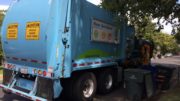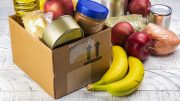Learn how you can reduce food waste on the front end
Reduce, reuse, recycle: Three short, simple steps have encouraged millions of people to take better care of our collective home. That first step—reduce—can make the biggest impact on the environment and our local community.
“You want to reduce first, reuse second and recycle last,” explains Annah Rulon, municipal sales manager with Republic Services. Rulon adds “there are not markets for everything in the world,” which is why reducing waste is critical.
Senate Bill 1383 is the Short Term Climate Pollutants Reduction Strategy that applies the core principle of reducing the amount of waste we generate to the food we produce and consume. While it’s main objective is to reduce greenhouse gas emissions by limiting the amount of food waste that pollutes landfills, there are additional benefits to the goals of 1383. Organic recycling and edible food recovery lessen the environmental impact of landfills, creates compost which contributes to resilient agriculture, and promotes sustainability through clean energy by anaerobic digestion programs.
“Being more cognizant when we’re preparing food, there’s always leftovers and we can save that food or ingredients for a future meal. We don’t have to have a giant feast every time we go to a party.
Annah Rulon, Municipal Sales Manager, Republic Services
“There are benefits to business owners, to farmers, to residents, even to people beyond California because greenhouse gasses affect us all. In order to reap these benefits, we need people to participate,” says Rulon.
While the benefits to keeping valuable organic waste out of landfills extend throughout California and beyond, Rulon says the biggest problem facing the program is a lack of participation. While reducing such a large amount of organic waste sounds daunting, small habits make a big difference.
Every day tips to reduce the amount of food that end up in your green waste bin include:
- Meal plan before grocery shopping. Planning out a weekly menu and necessary ingredients will reduce the amount of meat, produce and other foods that spoil waiting to be used.
- Find flexible recipes that use extra food or items that are about to go bad, such as soups, casseroles, or baking banana bread with over-ripe bananas.
- Practice effective food storage techniques that maximize freshness and prolong shelf life.
- Store perishable food and leftovers in prominent locations such as on countertops or at the front of the refrigerator as a reminder to eat them first.
- Freeze foods when large batches are made (soups, cookies, etc.) in small portion sizes to defrost later.
Rulon encourages businesses that generate wasted food to take an additional proactive approach to reduce waste by partnering with a food recovery organization, such as a local food bank, to feed hungry people and families before landfills.
“That’s part of SB 1383, trying to capture edible food before it goes to the landfill because so much food is thrown away,” Rulon says. “[It’s] good food that’s going to be thrown away because no one purchased it and they can get it into the mouths of hungry people that same day or within 24 hours.”
Reducing food waste requires planning on the front end to not over purchase/generate food, properly using the food you have, and then getting excess edible food to people.
In fact, keeping a low-waste mindset can be especially practical during holiday season or before parties, celebrations and festivities.
- Meal plan according to the number of guests. For example, each diner will eat about 1 to 1.5 pounds of turkey, so for a Thanksgiving dinner for five, an 8-pound bird will do.
- Encourage guests to bring their own reusable containers to take home leftovers instead of disposable containers. Bonus: The bigger container you bring, the more you can take home. Didn’t bring a container? No leftovers for you!
- If there’s an excess of leftovers after your annual parties, cut down on the amount of food you prepare or—if they are potlucks—only ask half of your guests to bring a dish. Ask the other half to bring something to the next celebration.
“We have this notion that bigger is better: ‘I’m going to have so much food,’ or ‘I’m going to have a feast,’ or ‘my casserole is going to be huge.’ The reality is these parties that we go to always have enough food to feed two or three times the amount of party guests,” Rulon says. “Being more cognizant when we’re preparing food, there’s always leftovers and we can save that food or ingredients for a future meal. We don’t have to have a giant feast every time we go to a party.”
For more information about organic recycling in the city of Elk Grove, go to www.elkgrovecity.org/recycling-and-waste/organic-recycling.






























